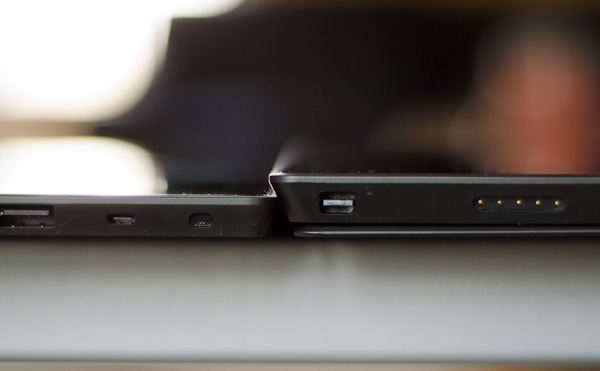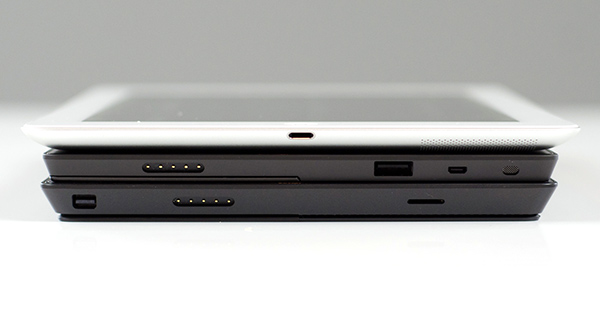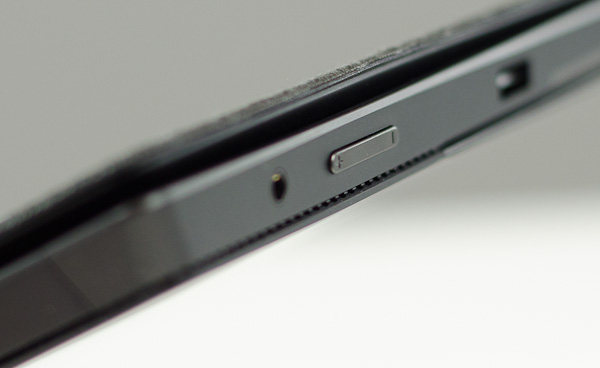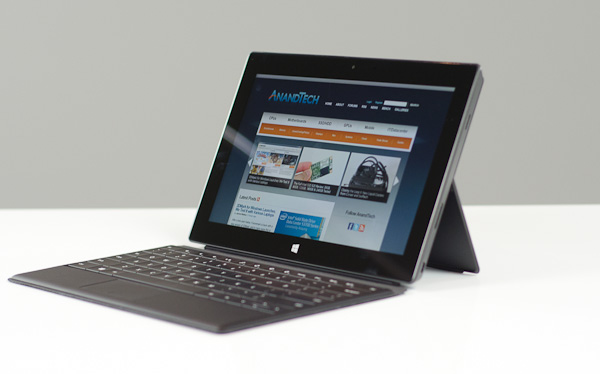Microsoft Surface Pro Review
by Anand Lal Shimpi on February 5, 2013 9:00 PM ESTSurface Pro Design
When I first saw Surface Pro, the Microsoft rep giving me the demo did a simple test. He stood Surface Pro right next to Surface, with the same start screen, and asked me if I could tell the two apart. The planar dimensions of Surface Pro are identical to Surface RT. Both feature the same sized 10.6-inch display, the same capacitive Windows button and the same 1-inch border around the screen. Looking head on, the only way you can tell the difference between Surface Pro and RT is the former’s 1080p display does make text a bit sharper.

Surface RT (left) vs Surface Pro (right)
Turn the two tablets to the side and the differences quickly become evident. Surface Pro is over 40% thicker than Surface RT (13.7mm vs 9.3mm). While the latter was of a similar thickness to an iPad with Retina Display, Surface Pro is clearly in a different league of dimensions.
The thickness of Surface Pro doesn’t really impede its portability, but the weight definitely makes it a lot less pleasant to carry around. Surface RT was already heavier than the competition but it hid its weight well. Surface Pro is just heavy for a tablet. I wasn’t originally impressed by the Surface RT form factor, but in switching between the RT and Pro models I immediately wish that Surface Pro came in the RT chassis and Surface RT came in something even thinner and lighter.

Surface Pro (left) vs. iPad 4 (right)

From top to bottom: iPad 4, Surface RT and Surface Pro
Shift the comparison to Ultrabooks however and all of the sudden Surface Pro seems quite light. It’s lighter than an 11-inch MacBook Air and Acer’s 11.6-inch Aspire S7 (although with optional keyboard cover it is heavier). It’s all about perspective. Compared to an iPad, Surface Pro is heavy, but compared to an Ultrabook or MacBook Air it’s light. The Pro model embodies the vision Microsoft had for the Surface family: to create a new type of device somewhere between a tablet and a notebook. That’s not to say there’s not room for improvement in the physical department. Surface Pro will likely go on a diet as it’s given more power efficient silicon, but even then you’ll always be able to build something thinner and lighter based on slower hardware, or go thicker and heavier with a notebook.
The fit and finish of Surface Pro are just as good as Surface RT. The tablet is built out of the same injection moulded Magnesium process (VaporMg) as Surface RT, however the chassis itself is somewhat simplified. While Surface RT featured three discrete VaporMg components (frame, back and kickstand), Surface Pro is made up of only two (single piece frame+back and kickstand). The result is no different to the end user, but the simplification on the assembly side is likely better for Microsoft.
I am fine laying the same praise on Surface Pro’s build quality as I did on Surface RT. The unique finish doesn’t feel like the aluminum we’re used to seeing on iPads, and definitely feels better than the plastic we’ve seen elsewhere. The VaporMg surface doesn’t feel like it would scratch easily, and after a few months with Surface RT I don’t see any visible scratches on my unit.
Surface Pro’s construction feels more utilitarian and understandably more oriented towards productivity, just like its little brother. I still believe that the Surface lineup is as much about Microsoft showing that it too can build high quality devices as it is about getting into the tablet market. If we compare it to the iPad, Surface Pro feels just as well built, if we compare it to every Windows RT and Windows 8 tablet or notebook on the market today - it’s worlds better. Say what you will about Microsoft entering the PC hardware business, but as of today Microsoft builds the best Windows RT and Windows 8 hardware on the market. If I ran a PC OEM I wouldn’t be angry at Microsoft, I’d be angry at myself for letting this happen.
Surface Pro retains the integrated kickstand from Surface RT, although the kickstand has been beefed up to accommodate the heavier tablet. Surface Pro’s kickstand keeps the device propped up at a fixed angle of 26-degrees away from the vertical axis. The rear facing camera is also angled to compensate (it shoots parallel to the ground with the kickstand opened).
The kickstand is allegedly good for over a million open/close cycles and it still doesn’t feel like something that would break. There are only two hinges in the kickstand compared to three for the RT model.
The kickstand on Surface Pro feels different than the kickstand on Suface RT. The Pro kickstand feels lighter and sounds less like metal and more like plastic if you tap on it. Feel around on the underside of the kickstand and you’ll notice a coating that seems to dampen sound and perhaps add some structure reinforcement to the design. Microsoft had to thicken the kickstand to support the added weight of the Surface Pro, but the difference is on the order of a fraction of a millimeter.
The tweaked kickstand does have different acoustics than Surface RT’s kickstand. While the latter sounded a lot like a thin metal door shutting, the Pro’s kickstand is far more muffled. I’d almost say it’s preferable.
Thankfully the kickstand’s functionality hasn’t been marginalized in the transition to the Pro. It’s still a highly integrated and very important part of the Surface experience. It’s simple to flip out and perfect for use on desks. You can make the kickstand work on your lap or chest if you’re lying down, but it’s not ideal for either unfortunately.
The more I use Surface (Pro and RT) the more I feel that Microsoft needs to pursue something a bit more flexible than the fixed 26-degree kickstand. The biggest issue by far is in-lap use with one of the keyboard covers attached. Depending on your seating position, the 26-degree angle that the kickstand opens at might be too small. Mechanically I don’t know the right solution for Microsoft but I do feel like for the kickstand to realize its true potential, it needs to be able to open and hold at multiple angles. It doesn’t necessarily need to have support for infinite angles, maybe even a few would work, but I do believe it’s necessary going forward.













228 Comments
View All Comments
HoushaSen - Friday, February 8, 2013 - link
Aside from the weight (1.8 lbs), the lenovo's upcoming Core hybrid tablet/ultrabook have one major advantage, which is the battery life. To be honest, 1.8lbs vs. 2.0lbs won't make a difference for me as anything over 1.5 lbs is just not comfortable to hold in one hand i.e. either way it won't work as pure tablet for me.So the true major benefit of getting Helix over the Surface Pro for me was the battery life. Despite both system having the identical battery capacity (42W), Lenovo claims 10 hours battery life because it has the battery equipped keyboard dock.
If MS truly releases one for Surface Pro, and obviously for the reasonable price I think the advantage of Helix goes away (remeber helix starts at $1499).
Plus when MS is designing this new keyboard, I hope they have also put lap friendly design for consideration as well to solve that issue.
But since battery life has been listed as one of the major downside of this device everywhere, I think MS should simply announce the dock on its way officially to at least make most people believe there is a way to extend battery life. Anyways, this is just my opinion.
Jaerba - Friday, February 8, 2013 - link
They teased the hell out of a battery keyboard dock during their AMA, so I expect it's on its way. I just wish they'd 100% confirm it and give a date.Really, a keyboard dock could solve three of its major problems (battery life, multiple viewing positions and keyboard quality.) You'd really just have the text scaling issue as the one major gripe.
IUU - Saturday, February 9, 2013 - link
So you get a computing device that is 5 times to more than an order of magnitude powerful compared to arm devices and still getting half the battery life, for not quite double the price?Not taking into consiferation that the next generation of Intel's processors will be significantly more efficient?
Being able to run any x86(legacy ... lol) program without relying on an "app" store?
Being able to expand and transfer memory any way you want, even managing to run demanding desktop programs, even though a bit slower than a desktop?
Sounds like a pretty good deal to me(compared to arm offerings), though something normal and expected in the pc world!
Tams80 - Saturday, February 9, 2013 - link
It looks good, but I think the Thinkpad Helix will probably be a better option when it's released, even though it will be more expensive. For someone like me, this would be a considerable purchase no matter what, so I'm more than prepared to pay more. The Fujitsu Q702 could be contender, but the display resolution is poor and the Sony Duo 11 is tempting, but is not a dock tablet and has limited keyboard space.My ideal tablet PC is a pipe dream.
-Something like the Fujitsu T902, but being a dockable/detachable, with a swivel 'docking bracket''.
-Ideally a dGPU - an AMD APU (with -G graphics) paired with AMD -M graphics in hybrid crossfire. The dGPU would be in the dock.
-mSata SSD in the tablet/lid
-HHD/SSD in dock
-modular bay in dock
-Anytime USB charge on at least two USB ports
-USB 3.0 ports, one/two on tablet, at least two on dock
-LightPeak/Thunderbolt/whatever that mess seems to be doing
-Active digitiser - Wacom Penabled still appears to be the best
-SD/other card reader
-large trackpad on dock with physical buttons
-13.3 display
-1920x1200 display (or double that resolution)
-ample bezel buttons
-at least acceptable speakers
-1080p webcam, or whatever the marketing term used now is
-some decent microphones
-trackpoint/whatever other companies call it?
-ExpressCard? Is there an updated version?
-not sure about a rear camera - rather pointless on such a device
Yeah. That's never going to happen.
topdomino - Saturday, February 9, 2013 - link
In december, you called the Dell XPS 12 "the coolest ultrabook around" and mentioned that fliping the screen creates a tablet.http://www.anandtech.com/show/6510/holiday-2012-ul...
Given that the specs on the 128 GB Surface Pro and the current base model of the Dell XPS 12 are so similar:
Surface Pro: 1.6GHz base clock, 4 GB Ram @ 1600MHz, Intel HD 4000 graphics, 128 GB SSD, $1,128 (with Type cover);
Dell XPS 12: 1.7GHz base clock, 4 GB Ram @ 1333MHz, Intel HD 4000 graphics, 128 GB SSD, $1,199 (comes with keyboard);
I would have expected a direct comparison between them to be the most useful one.
bogieworf - Saturday, February 9, 2013 - link
Comes down to whether you want a PC that is more like a tablet or a laptop. That smaller dimensions of the Pro are simply more tablet like, Of the two, the XPS is probably the better bet right now.Because it is convertible size, it has fewer tablet like demansd made of it. For example, I never heard of the XPS 12 being slammed for battery life like the Pro because the XPS battery life is in line with most convertibles on the market. The larger size also allows for a better keyboard. It also has a wider, and more convertible like array of specs.
The Pro is tablet size and people expect it to perform like a tablet. Unfortunately, that requires Haswell and probably a cellular option as well. Both will probably come with the Pro 2.
Death666Angel - Sunday, February 10, 2013 - link
All I read there is "cater to the stupidest among us". The XPS12 looks less like a tablet so less people will expect it to behave like a tablet as opposed to the Surface Pro? How brain damaged should we expect consumer to be?Actually, pretty brain damaged if I go by most reviews, which treat the Surface Pro as an iPad competitor and rank it accordingly. It boggled my mind.
damianrobertjones - Saturday, February 9, 2013 - link
How come none of them appeared in the battery life section? They actually, in some cases, destroy the competion in performance and battery life?Death666Angel - Sunday, February 10, 2013 - link
How would an Atom powered anything destroy a Core i-5 powered anything (or anything that is above a Celeron really)? Battery life? Sure. But what good is 6 hours of continuous use when you have to limit what you actually can do with it vs. 3 to 4 hours of continuous use without limits? If you need the battery life and don't need the performance, the choice is clear. And vice versa. :)I would have liked to see a comparison with the Samsung XE700T and the Acer W700 (which is perfect except for lacking a digitizer). But I can understand that they don't have everything.
lmcd - Sunday, February 10, 2013 - link
but I'm more interested in what happens when Google puts out a better version of their Chrome mobile browser. As noted, the Nexus 10 wasn't that horribly off from the Surface Pro, and I think with some OS optimization (or replacement with a nice KDE Plasma Active setup :-) a Nexus 10 + keyboard dock of some kind would knock out the Surface Pro and RT in one shot.